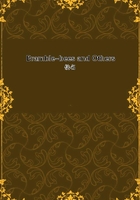
第44章 INSTINCT AND DISCERNMENT.(3)
But the spacious domain under the tiles is not within the reach of all: sheds with free access and the proper sunny aspect are pretty rare. These sites fall only to the favoured of fortune. Where will the others take up their quarters? More or less everywhere. Without leaving the house in which I live, I can enumerate stone, wood, glass, metal, paint and mortar as forming the foundation of the nests. The green-house with its furnace heat in the summer and its bright light, equalling that outside, is fairly well-frequented. The Mason-bee hardly ever fails to build there each year, in squads of a few dozen apiece, now on the glass panes, now on the iron bars of the framework. Other little swarms settle in the window embrasures, under the projecting ledge of the front door or in the cranny between the wall and an open shutter. Others again, being perhaps of a morose disposition, flee society and prefer to work in solitude, one in the inside of a lock or of a pipe intended to carry the rain-water from the leads; another in the mouldings of the doors and windows or in the crude ornamentation of the stone-work. In short, the house is made use of all round, provided that the shelter be an out-of-door one; for observe that the enterprising invader, unlike the Pelopaeus, never penetrates inside our dwellings. The case of the conservatory is an exception more apparent than real: the glass building, standing wide open throughout the summer, is to the Mason-bee but a shed a little lighter than the others. There is nothing here to arouse the distrust with which anything indoors or shut up inspires her. To build on the threshold of an outer door, or to usurp its lock, a hiding-place to her fancy, is all that she allows herself; to go any farther is an adventure repugnant to her taste.
Lastly, in the case of all these dwellings, the Mason-bee is man's free tenant; her industry makes use of the products of our own industry. Can she have no other establishments? She has, beyond a doubt; she possesses some constructed on the ancient plan. On a stone the size of a man's fist, protected by the shelter of a hedge, sometimes even on a pebble in the open air, I see her building now groups of cells as large as a walnut, now domes emulating in size, shape and solidity those of her rival, the Mason-bee of the Walls.
The stone support is the most frequent, though not the only one. Ihave found nests, but sparsely inhabited it is true, on the trunks of trees, in the seams of the rough bark of oaks. Among those whose support was a living plant, I will mention two that stand out above all the others. The first was built in the lobe of a torch-thistle as thick as my leg; the second rested on a stalk of the opuntia, the Indian fig. Had the fierce armour of these two stout cactuses attracted the attention of the insect, which looked upon their tufts of spikes as furnishing a system of defence for its nest? Perhaps so.
In any case, the attempt was not imitated; I never saw another installation of the kind. There is one definite conclusion to be drawn from my two discoveries. Despite the oddity of their structure, which is unparalleled among the local flora, the two American importations did not compel the insect to go through an apprenticeship of groping and hesitation. The one which found itself in the presence of those novel growths, and which was perhaps the first of its race to do so, took possession of their lobes and stalks just as it would have done of a familiar site. From the start, the fleshy plants from the New World suited it as well as the trunk of a native tree.
The Mason-bee of the Pebbles (Chalicodoma parietina) has none of this elasticity in the choice of a site. In her case, the smooth stone of the parched uplands is the almost invariable foundation of her structures. Elsewhere, under a less clement sky, she prefers the support of a wall, which protects the nest against the prolonged snows. Lastly, the Mason-bee of the Shrubs (Chalicodoma rufescens, PEREZ) fixes her ball of clay to a twig of any ligneous plant, from the thyme, the rock-rose and the heath to the oak, the elm and the pine. The list of the sites that suit her would almost form a complete catalogue of the ligneous flora.
The variety of places wherein the insect instals itself, so eloquent of the part played by discernment in their selection, becomes still more remarkable when it is accompanied by a corresponding variety in the architecture of the cells. This is more particularly the case with the Three-horned Osmia, who, as she uses clayey materials very easily affected by the rain, requires, like the Pelopaeus, a dry shelter for her cells, a shelter which she finds ready-made and uses just as it is, after a few touches by way of sweeping and cleansing.
The homes which I see her adopt are especially the shells of Snails that have died under the stone-heaps and in the low, unmortared walls which support the cultivated earth of the hills in shelves or terraces. The use of Snail-shells is accompanied by the no less active use of the old cells of both the Mason-bee of the Sheds and of certain Anthophorae (A. pilipes, A. parietina and A. personata).